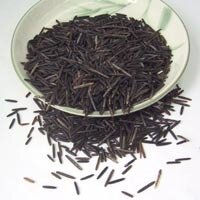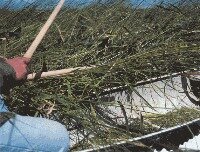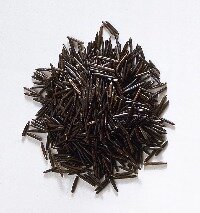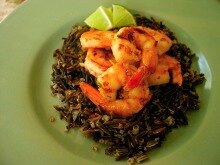
You may already know that choosing brown rice over white rice is among the possible brain-healthy, body-friendly dietary choices you can make to help reduce your overall intake of blood sugar-raising, high simple carbohydrate foods -- the foods (and drinks) which provide little nutrition while promoting the sugar-high rollercoaster process causing everything from obesity, fatigue, emotional crashes, even increasing risk of dementia.
While white rice is certainly among the lesser of the modern dietary evils, particularly compared to the likes of enriched breads, cookies, donuts, sodas, popular cereals and the like, many don't realize the truth about rice -- and that there's a truly exponentially better and tastier rice option out there that's actually not even a "rice" at all (read on).
And when it comes to brain health, physical health, carb intake, and longevity, it's high time that the word got out about the truly better rice (including taste) that may become your new daily staple.
Once you go wild, it's hard to go back.
Ever heard of wild rice? You probably have, perhaps as included as a side dish, stuffing, or the Minnesota favorite -- Wild Rice Soup. But before you rush to the store to buy a bag of something called "wild rice", read on, as seeing "wild rice" on a package is about the same as seeing the words "green tea": there are many varieties, sources, and options, and they are most definitely not all created equal when it comes to the astounding (and little-known) nutritional qualities of true whole, long stem, organic black hand-harvested wild rice from the Great Lakes region of the middle United States (yes, you have to get specific...even if the related varieties and quality levels offer similar nutritional benefits in some cases).
First of all, what is it?
Contrary to what many people believe, wild rice is not a "rice" at all, but rather an aquatic grass. Much of it sold in the world today is not even wild but rather cultivated varieties that do not occur naturally -- something you usually won't see mentioned on common "wild rice" mixes in the supermarket. Wild rice is really an aquatic seed known as Zizania Aquatica found mostly in the upper freshwater lakes of Canada, Michigan, Wisconsin, and Minnesota in North America.

Historically, many native American Indian tribes used wild rice as an important staple in their diets and considered it the centerpiece of their Megwetch Manomin Feast that followed the first harvest. During the long, cold winters when the lakes were frozen and hunting was difficult, their precious stores of wild rice nourished -- often as the primary element of their diet, a testament to the nutritional properties. They had great reverence for "the precious grain sent by the Great Spirit to serve as food." The grain was so valuable to subsistence that tribes sometimes waged wars over wild rice territories. The Chippewa tribe even carried small pouches of wild rice with them whenever they traveled.
Before any explorers set foot on the North American continent, wild rice was gathered by Indians over an expansive of area North America from the Atlantic coast to the Mississippi Valley. Archeologists found charred remains of wild rice seeds in threshing pits in the northern states that existed long before there was contact with Europeans. By the early part of the1900s, only clear lakes and rivers of the most northern regions of Minnesota could still support the growth of wild rice and provide the Indians their staple food.
It became known as "wild rice" because the explorers noticed Indians gathering it in the waters of the Great Lakes region. As they observed it rising 3 or 4 feet above the water, it reminded them of rice paddies.
How does it taste?
Cooked wild rice has a rich nutty flavor, sometimes described as a smoky flavor, and a texture that is satisfyingly chewy. The slender, elongated grains that often come to market are usually about one-half inch in length and almost black in color with some touches of green. Premium grades of truly wild, uncultivated wild rice sold in gourmet markets can be as long as one-inch and the colors can vary from medium brown to nearly pure black.
Though wild rice is mostly associated with the United States and Canada, it is also grown in areas of Africa, Southeast Asia, and Southern China. China grows another species called Z. latifolia, sometimes called Manchurian wild rice. The Chinese favor these plants not for their cereal grains, but for their broad leaves and young shoots that they incorporate into their cuisine. The leaves are used to wrap dumplings, while the shoots are cooked and eaten like asparagus.
A nutritional powerhouse

Simply put, wild rice blows away other grains when it comes to amounts of protein, minerals, B vitamins, folic acid (particularly important for brain health and warding off mental diseases), and "good" carbohydrates.
It has almost twice the protein content of the venerable brown rice (and nearly EIGHT times the protein of white rice!), and has only 83 calories for 1/2 cup cooked.
It has almost SIX times the amount of folic acid as brown rice(!), making it one of the best sources of the all-important folic acid that one can eat.
The niacin content of wild rice is also a stand-out figure, with l.06 mg for 1/2 cup cooked. Potassium packs an 83 mg punch, and zinc, which is usually available in trace amounts, registers 1.1 mg.
While 1/2 cup cooked wild rice offers 1.5 grams of fiber, it contains 26 mg of magnesium, a healthy balance of B vitamins and only .3 grams of unsaturated fat. Small amounts of calcium and iron are also part of the wild rice picture.
In short, wild rice is a high-protein, nutrient-rich, 100% vegan, economical (compared to many other foods) superfood that is also particularly noteworthy for brain health & longevity concerns due to its unique mix of properties. Isn't it time to not only move wild rice from the "occasional side dish" status into a frequent dietary staple? But before you get some, here's what you need to know (and that the store packaging won't tell you):
There are two types of wild rice: gathered and commercial. Hand-harvested wild rice is gradually being pushed out of the market by hybrid commercial varieties. Hand harvested wild rice makes up less than 20% of the market today, yet fortunately, heirloom varieties of this foraged grain still exist. In fact it is the only heirloom grain sold commercially.

However, package labels can be deceiving: though the label may read, "Indian harvested," or "organic," the product may indeed be hybridized wild rice placed in freshwater lakes and gathered by Indians in airboats. "Hand harvested, organic, and from the Great Lakes region" is the real thing with superior flavor and aroma, but it may be difficult to find (check natural foods stores, organic groceries, online store, and upscale markets to find the real thing).
Before purchasing wild rice, you should be aware of the principal grades available:
- "Giant" or "long grain" is the top quality with each unbroken grain measuring at least an inch in length. Its earthy flavor makes it a favorite of chefs who are willing to pay top price.
- "Fancy" or "medium grain" has rice that is unbroken and similarly matched in color and length but not as long as the giant. This grade will cost slightly less than the Giant.
- "Select" or "short grain" has kernels that are not uniform in size or color, and some of the kernels may be broken. For most purposes such as in soups, casseroles, and in combination with brown and white rice, this grade is ideal.
Cooking
Wild rice should be rinsed before cooking to remove any unwanted particles, such as hulls or storage debris. Put the grains into a saucepan with warm water to cover, and stir the rice around to allow any particles to float to the top. Skim off the particles and drain the water. It's best to repeat the rinsing one more time before cooking.

As a general rule established proportions for cultivated wild rice use1 cup of dry wild rice to 3 cups of water, with salt to taste. We suggest 1 teaspoon of salt. Combine these in a 2 or 3-quart saucepan, cover, and bring to a boil over high heat. Turn heat down to medium low, and steam for 45 minutes to 1 hour. When fully cooked, the grains open to reveal their purplish-grey inner portion, giving each grain a striking two-tone appearance. This quantity will yield about 3 to 4 cups of cooked grains, depending on variety.
Wild-crafted wild rice proportions should use 1 cup of grain to 2 cups of water with a cooking time of 45 minutes.
The principal challenge in preparing wild rice is that there are variations in the cooking times. Rice gathered naturally has part of its bran layer removed during the hull removal stage and so lessens its cooking time. Commercially grown rice that does not have any of the bran layer removed may take an hour or more to cook, while gathered rice may only need 45 minutes. A taste test is your best method. The fully cooked grains should not be mushy nor should they be crunchy. Aim for a texture that is pleasantly chewy.
One of the cheapest superfoods?
Though wild rice is one of the most expensive grains comparatively, it goes a long way, and looks like a steal when compared to the other common foods (particularly packaged, processed ones) that most of us regularly buy. Some say that "one pound of the grain can feed thirty people". At BrainReady, we've found that a relatively small bag of organic black wild rice from a local natural foods grocery store yields enough wild rice for daily side dishes for a full week(!), which translates to an almost ridiculously cheap, tasty brain & body-healthy food source.
Endless culinary options
As you can imagine, wild rice can be prepared and combined in an almost endless variety of ways. Try it straight with some extra virgin olive oil, salt, pepper, and a touch of cayenne. Or kick up the brain health by adding some turmeric, eggplant, tomatoes. Or cook with some organic free-range chicken (or vegetable) stock and several vegetable varieties. Options are endless, similar to pasta -- but exponentially healthier.
It's also ideal for vegetarians, serving as an ideal vegan main dish, side dish and dietary staple (with its high protein, B-vitamin and other nutritional content).
So next time you think of rice, go wild instead. Your brain and body will thank you, as will your taste buds.
(What do you think of true wild rice? Share your opinions, recipe tips and thoughts by clicking the 'Comments' link below....)




